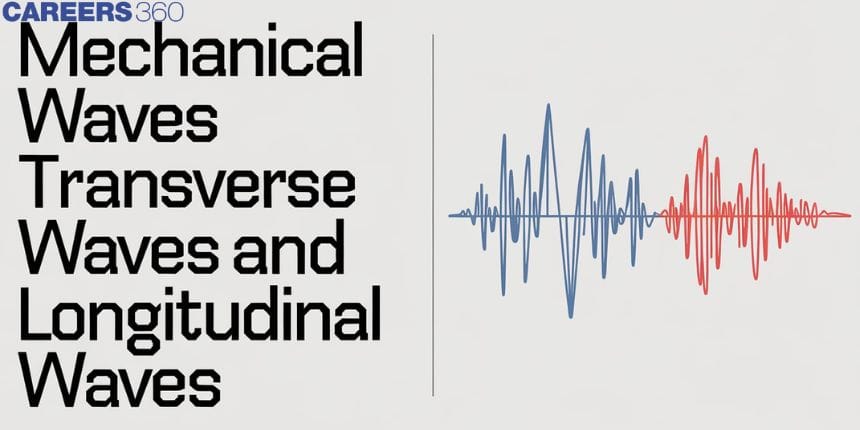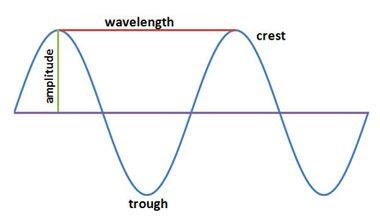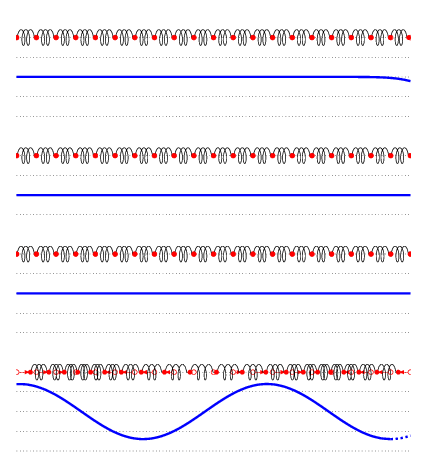Mechanical Waves Transverse Waves and Longitudinal Waves
Introduction
In this article, our focus will be on what are transverse waves and longitudinal waves and examples of transverse waves and longitudinal waves etc.
What are transverse waves and longitudinal waves?
Transverse waves are the oscillations in which the particles travel perpendicularly to the direction of wave propagation whereas Longitudinal waves are the oscillations in which the particles travel parallel to the direction of wave propagation.
Now let’s discuss elaborately about: -
1. Transverse waves
A. What is a transverse wave? or Define Transverse wave.
At first, we need to know what is transverse or the meaning of transverse.
Transverse means lie or being across and in Hindi it means तिरछा कटा, अनुप्रस्थ and in Malayalam it means തിരശ്ചീന
In physics, transverse waves are moving waves whose vibration is perpendicular to the direction of the wave. By connecting one end of the rope and moving the other end up and down, a simple demonstration of waves can be created on the horizontal length of the rope. Light is another example of transverse waves, where vibrations are electric and magnetic fields at right angles to the ideal light rays describing the direction of propagation. They are also called latitudinal waves.
Shear waves often occur in elastic solids. In this case, vibration is the displacement of a solid particle from its relaxed position in a direction perpendicular to the direction of wave propagation. Shear waves are also called secondary waves or shear waves in seismology.
Also read -
- NCERT Solutions for Class 11 Physics
- NCERT Solutions for Class 12 Physics
- NCERT Solutions for All Subjects
JEE Main/NEET 2027: Physics Important Formulas for Class 10
NEET 2025: Mock Test Series | Syllabus | High Scoring Topics | PYQs
JEE Main: Study Materials | High Scoring Topics | Preparation Guide
JEE Main: Syllabus | Sample Papers | Mock Tests | PYQs
- What are transverse waves and longitudinal waves?
- 1. Transverse waves
- 2. Longitudinal waves
- Difference between longitudinal waves and transverse waves

B. Characteristics of transverse waves
- In the case of waves, when the oscillation of the particles in the medium is perpendicular to the direction of wave propagation, such waves are called transverse waves.
- Transverse waves propagate in the form of a series of crest and troughs.
- The distance between 2 consecutive peaks or troughs is termed the wavelength.
- Due to the elastic properties of the solid medium, this wave is generated in the solid medium, and the transverse wave is generated due to the surface tension of the liquid medium. Energy is transported from left to right by crawling. When energy is transmitted from left to right, the turns of the medium move up and down.
C. Examples of Transverse waves
Even if it is a transverse wave, the particles will not move with the wave. They move up and down in the equilibrium position. Some examples of transverse waves are
- Waves on the water surface
- Secondary waves of an earthquake
- Electromagnetic waves
- Waves on the strings
- Waves of stadiums or people
- Waves of Ocean
D. Transverse waves diagrams

The above diagram is the transverse wave image.
2. Longitudinal waves
A. What are longitudinal waves? Or Define longitudinal waves
First, we need to know the meaning of longitudinal.
Longitudinal means going lengthwise and in Hindi it means अनुदैर्ध्य
Longitudinal waves are those waves in which the oscillation of the medium is in the same direction as the wave’s propagation direction.
The distance between the centres of two consecutive compressed or thinned regions is defined by the wavelength. When the compression and thinning regions of two waves coincide, it is called constructive interference, and when the compression and thinning regions do not coincide, it is called destructive interference.
Examples of longitudinal waves: Acoustic waves are an example of longitudinal waves, which are generated by the vibrational movement of particles passing through a conductive medium. An example of longitudinal sound waves is a tuning fork.
In the case of sound waves, the amplitude of the wave is the difference between the maximum pressure caused by the wave and the undisturbed air pressure. The propagation speed of sound depends on the type and composition of the medium and the temperature at which it propagates.
Also read :
- NCERT notes Class 11 Physics Chapter 15 Waves
- NCERT solutions for Class 11 Physics Chapter 15 Waves
- NCERT Exemplar for Class 11th Physics Chapter 15 Waves
B. Characteristics of longitudinal waves
- Compression
In longitudinal waves, compression is the area in the wave where the particles are closest to each other.
- Sparse
is the longitudinal wave when the particles are farthest apart.
- Wavelength
The distance between two consecutive points in a longitudinal wave is called the wavelength. These consecutive points can be between two compressions or between two dilutions.
- Amplitude
is the maximum displacement of a particle from a stationary point.
- Period and Frequency
The time required for a Wave to propagate one wavelength is called the period.
The frequency of longitudinal waves is the number of wavelengths per second.
Related Topics Link, |
C. Examples of longitudinal waves
- Sound waves in the air:
Yes, sound waves are longitudinal in nature. When we speak, sound waves travel through the air medium and reach the audience. An example of a sound wave in the longitudinal direction of propagation is a tuning fork. In the case of acoustic waves, the amplitude of the wave is always the difference between the maximum pressure caused by the wave and the undisturbed air pressure. The propagation speed of sound depends on the type and composition of the medium and the temperature at which it propagates.
- The primary wave of an earthquake:
It is said that animals can perceive earthquake waves better than humans. You have the ability to perceive seismic P waves that only propagate inside the earth. Even humans can experience the slight bumps and creaks of these waves, but most of the time they are imperceptible to us. P waves are the fastest waves. They require a medium to move solids or liquids. The P wave causes the inside of the earth.
- Tsunami wave:
We know that a tsunami is a dangerous natural disaster that will cause serious losses to people. Tsunamis will destroy coastal areas (coasts), which is why people in coastal areas are afraid of tsunamis. Most people think that ocean waves are transverse waves because they are constantly moving back and forth, that is, constantly fluctuating up and down. However, water waves or ocean waves including tsunamis are examples of transverse and longitudinal waves.
NCERT Physics Notes:
D. Longitudinal waves diagram

The above diagram is the pics of longitudinal waves.
Difference between longitudinal waves and transverse waves
| Sl. No. | Longitudinal waves | Transverse waves |
| 1. | Longitudinal waves are the oscillations in which the particles travel parallel to the direction of wave propagation | Transverse waves are the oscillations in which the particles travel perpendicularly to the direction of wave propagation |
| 2. | Longitudinal waves are composed of compression and dilution, so they are also called compression waves | The transverse wave is composed of crest and trough |
| 3. | Longitudinal movement/waves can propagate through any medium, for example. Longitudinal waves can propagate through gaseous media, air media, water, solids, etc. | Transverse waves can only propagate through the surface of solid and liquid media. |
Also check-
Frequently Asked Questions (FAQs)
Vibration in which the element reciprocates in a direction perpendicular to the direction of advancement of the shaft is called transverse vibration.
Sound waves are longitudinal in nature. When we speak, sound waves travel through the air medium and reach the audience. An example of a sound wave in the longitudinal direction of propagation is a tuning fork. In the case of acoustic waves, the amplitude of the wave is always the difference between the maximum pressure caused by the wave and the undisturbed air pressure. The propagation speed of sound depends on the type and composition of the medium and the temperature at which it propagates.
Transverse direction usually indicates a direction or plane perpendicular to the working direction.
No, sound waves are longitudinal in nature.
Water waves are an example of waves involving a combination of longitudinal and lateral motion. When the wave passes through the wafer, the particles move clockwise. The radius of the circle decreases as the water depth increases.
A mechanical wave is a wave that cannot transfer energy through a vacuum. Mechanical waves would like a medium to transfer their energy from one place to another.
Sound waves and water waves are mechanical waves.
TVs, radios use the transverse waves for telecasting.
In a stretched spring, transverse waves are present.
Seismic waves, sound waves.
Also Read
25 Nov'24 02:09 PM
20 Nov'24 05:36 PM
19 Nov'24 02:33 PM
12 Nov'24 10:05 PM
12 Nov'24 07:12 PM
25 Sep'24 03:49 PM
24 Sep'24 10:06 PM
24 Sep'24 06:25 PM
24 Sep'24 04:58 PM